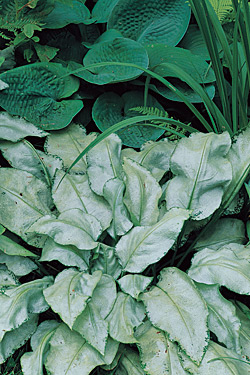
Plant sheen — ‘Excalibur,’ a silver-leafed lungwort (Pulmonaria) shines in the shade when paired with a solid green Hosta. © Karen Bussolini
There are lots of reasons to like silver plants.
First, most silver plants are deer resistant. Second, they are usually drought tolterant and third, “silver is really pizzazy with other colors,” says Karen Bussolini, who with Jo Ann Gardner, wrote Elegant Silvers: Striking Plants for Every Garden (Timber Press, $34.95).
“Once we started comparing notes on what silvers we had grown, we came up with a really long list, both of silvers we had killed and ones that had been successful,” said Bussolini, who lives in Connecticut. She will speak about these shimmering garden jewels at 7:30 p.m., Nov. 10 at Woodstock Club, 1301 W. 38th St., Indianapolis. The lecture, sponsored by the Indianapolis Museum of Art Horticultural Society and the Indianapolis Hosta Society, is free and open to the public.
While Bussolini traveled the country looking for gardens and interviewing gardeners, Gardner remained on her farm in the Adirondacks conducting research. They spent four years working on the book, said Bussolini, an award winning photographer whose images illustrate the book.
Several characteristics contribute to silvery plant hues, such as hairy foliage, waxy coatings or scales. The color penetrates plant groups, too, showing up in grasses, succulents, evergreens, herbs, shrubs, perennials, native plants and tropicals. Here is a sampling of her favorites:
- Silver pony foot (Dichondra) ‘Silver Falls,’ a tender perennial grown as an annual in Indiana because it is not winter hardy. “Whether hanging from a container or scrambling along the ground through other plants, it is always beautiful, and looks great no matter what you combine it with.”
- Japanese painted fern (Athyrium) ‘Ghost,’ with silver fronds. The perennial fern, winter hardy in USDA Zone 5 “is my favorite silver for shade.”
- Blue avena grass (Helictotrichon sempervirens) ‘Sapphire,’ a spiky specimen, winter hardy in USDA Zone 4, “that combines beautifully with vibrant colors and rounder forms.”
The biggest mistake when planting silver plants is poor drainage and air circulation, Bussolini said. “The variegated silvers want a moist woodland soil, but downy or waxy silvers, having adapted to lack of moisture, keel over if they get too much. I have learned the hard way that silvers that don’t make it through the winter usually succumb because of moisture trapped around their crowns, not because of the cold.”